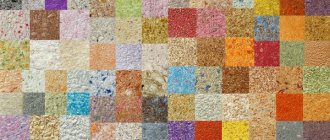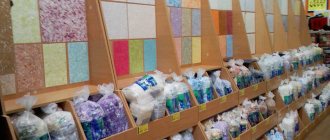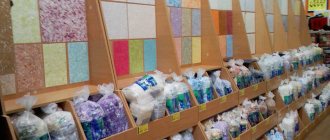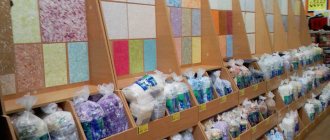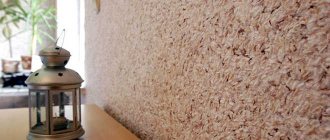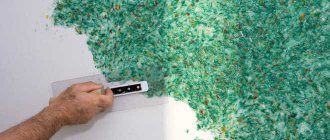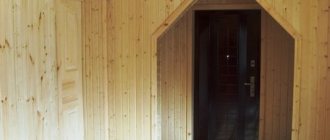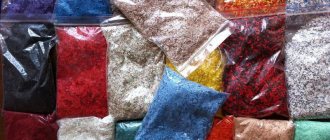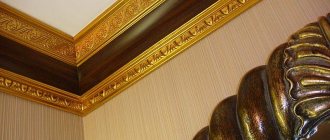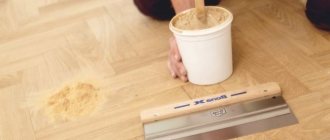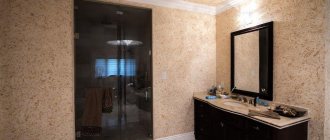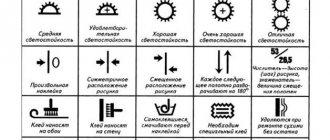Liquid wallpaper is a relatively new material for wall decoration. They perform two functions at once: decorative coating and plaster. However, many users are confused by their name: “liquid wallpaper”. Having heard it and not understanding the features of the material, people decide that it cannot be used for finishing drywall, because the latter is afraid of water. How true or false is this judgment? And is it possible to apply liquid wallpaper to drywall? We need to look into this in more detail.
So is it possible or not?
Don't think that this wallpaper is as liquid as water. In fact, when finished, they have a rather dense structure, reminiscent of putty or plaster in consistency. Wallpaper is made from a mixture of cellulose, glue, decorative elements (for example, glitter, shaped particles), cotton fibers, silk or other textiles. Dry ingredients are mixed with water (the proportion is indicated in the instructions). Then the mixture is infused and a fairly thick solution is obtained, which can be applied to walls made of any material.
Liquid wallpaper does not contain very much water. This amount of liquid will not harm the material of the partition. Therefore, you should not be afraid that the drywall will swell, change shape, etc. By the way, if this material is properly prepared, then it will not be afraid of large volumes of water.
Can silk plaster be applied to drywall?
When working with surfaces made from gypsum board sheets, a problem arises when it is necessary to determine the correct method of laying the material. The fact is that the base does not always have good adhesion to the selected product. But when using liquid wallpaper, whose second name is “silk plaster,” for finishing, such difficulties do not arise.
The technology for applying this material involves two methods. They have some differences, but are equally effective:
- Full putty. This process involves pre-finishing the entire drywall surface. The resulting layer has good adhesion and greatly facilitates the procedure for dismantling the decorative coating, if necessary in the future.
- Installation without putty. This method avoids lengthy surface preparation. Liquid wallpaper on a cellulose or cotton basis is perfectly applied to cardboard, providing reliable adhesion, but if it is necessary to remove the decorative layer, a lot of problems will arise. The fact is that the adhesion between the material and the top coating of gypsum board sheets is very high, so it will be impossible to remove the cladding without damaging the boards.
Home craftsmen mistakenly think that penetrating primer paint can replace putty; in fact, this material is intended for other purposes.
Silk plaster is excellent for finishing plasterboard surfaces, provided the correct technology is chosen.
Features of liquid wallpaper
After drying, the wallpaper becomes soft, even silky. However, an interesting design effect is not the only advantage of this finishing material. The advantages of liquid wallpaper include:
- absence of joints, overlaps and other types of seams on the finished coating;
- ease of repair of any damage (it is enough to dilute a small amount of dry mixture and cover up the dirt or scratch);
- unlimited scope for flight of imagination, with the help of this wallpaper you can create complex designs;
- environmental friendliness - they contain only natural ingredients;
- ease of application;
- leveling of surface irregularities and defects;
- long service life - up to 10 years.
USEFUL INFORMATION: Drywall putty technology
Of course, they also have a number of disadvantages:
- easily absorb odors;
- don't wash;
- contaminants easily penetrate into the structure of the material;
- the effect of water on dried wallpaper can be destructive;
- upon contact with furniture and other objects, they can quickly wear out at the points of contact.
Which primer to choose
Almost any primer with a moisture-proof effect is suitable for preparatory work. The main purpose of the primer is to increase adhesion to the base. If desired, you can use Silk Plaster material; it has excellent quality and good moisture-proof properties. When choosing a primer, you should focus on the country of manufacture, the characteristics of the material, as well as the price range.
The primer is applied in 2-3 layers
Varieties
Depending on what material is used as the base, liquid wallpaper is divided into:
- cotton;
- silk;
- cellulose;
- combined.
There are mixtures that are completely ready-to-use, to which you only need to add a certain amount of water. There are also wallpaper mixtures that you can make yourself, that is, mix the components yourself in the required proportion: dye, filler, decorating elements.
Conclusion
Applying liquid wallpaper is not difficult, especially if you have properly prepared the plasterboard base and leveled it. Moreover, you can create interesting compositions, even if you have never done such work and have no experience in this field. The video in this article will help you understand the topic even better and clearly show important aspects of the work process. If you have any questions, write them in the comments below.
Did you like the article? Subscribe to our Yandex.Zen channel
October 22, 2016
Plasterboard systems, Wallpaper, Finishing materials
If you want to express gratitude, add a clarification or objection, or ask the author something, add a comment or say thank you!
How to prepare liquid wallpaper
The cooking rules will be as follows:
- The required amount of slightly hot water is taken into a plastic basin (temperature no higher than 50 degrees).
- Then pour the dry mixture into the container and mix.
It is better to mix the wet wallpaper mass with your hands, so as not to damage the components of the mixture, and also to thoroughly knead all the lumps.
- Then the prepared mass is left for several hours to infuse.
- The finished mixture can be used immediately or stored in a closed container for several days (usually no longer than 5 days).
Features and Recommendations
The process of gluing wallpaper will not be difficult if you follow the recommendations:
- The plasterboard surface does not have small stones or wave transitions.
- All containers and tools must be clean.
- When working with wallpaper, you need to remove all the shortcomings, otherwise it will be impossible or difficult to do this later.
Tips for working with wallpaper on a plasterboard surface:
- Work on pasting a room begins with a doorway or window.
- Wallpaper should be measured and cut on a horizontal, clean surface - a clean floor, a large table.
- During gluing, the canvas is completely free of air bubbles. Do this carefully with a soft rag or rubber spatula.
- Excess glue that comes to the surface of the canvas is removed immediately with a damp sponge.
- If the wallpaper has a large pattern, then the consumption of the pattern at the joint is allowed to be no more than 2 mm.
- Trimming of excess trellises is done strictly along a ruler with a sharp knife.
- During work, windows and doors must be closed.
Having familiarized yourself with the recommendations and tips, the work of gluing a plasterboard surface will not be difficult or time-consuming. To avoid unpleasant consequences, such as dark stains from moisture-resistant drywall on trellises, the surface still needs to be covered with putty and primer. This guarantees the appearance of the room and the durability of the trellis covering.
How to prepare drywall
Preparing the drywall is one of the most important elements. The quality of further work, as well as the safety of the drywall itself, depends on how this stage is completed.
What should be done:
- Carefully putty all the seams between the sheets. Otherwise, tears or cracks in the finish will appear over time. In addition, the material cannot be applied evenly to the bumpy surface.
- Process the screw heads. First they are treated with a primer solution or painted. This is necessary to prevent corrosion from corroding the steel. Due to rust, unsightly stains and stains may appear on the wallpaper.
- Cover the screw heads with putty. This will completely level the surface.
USEFUL INFORMATION: Plasterboard or suspended ceiling, which is better and cheaper?
- If time allows, completely putty the entire surface of the walls, having previously primed them. This will prevent contact of liquid wallpaper with the top layer of drywall. Also, stains will not appear through the material, since the entire surface will be uniform.
- Prime drywall or putty. The liquid will fill all the micropores on the walls. Thanks to this, the finishing material will not penetrate inside the walls, so it will be easy to remove later. In addition, this will completely eliminate contact between the wallpaper and the drywall. Also, applying a primer improves adhesion.
When the drywall has been processed, you can begin applying liquid wallpaper. They are evenly rubbed over the entire surface of the walls. For primed and putty material, such finishing does not pose a threat at all. Therefore, we can safely say that liquid wallpaper can be applied to drywall.
Stages of work
At the first stage, it is necessary to prepare the wall surface. Yes, you don’t have to use putty, but it’s better to apply a thin layer to seal the joints. Be sure to coat metal parts with an anti-corrosion compound. Before applying the base material and drying the putty, be sure to use water-based paint, which will give the overall color to the space.
Pasting liquid wallpaper
Be sure to follow the instructions provided by the manufacturer. The prepared material can be stored for 5 days if the temperature always remains at 20 degrees. So, no one will rush you to do the work.
To apply the material correctly, you need to take a wide spatula. It is important to work from corner to corner without pressure, but also without stopping. This will prevent the formation of joints and sagging. After applying the coat, leave the surface to dry.
Drawing
You can then add a design on top if you want to add even more style to the room. In this case, you can use stencils if you are not a professional artist. Many specialists provide similar drawing services, so sometimes it makes more sense to turn to professionals.
If you decide to do everything yourself, then remember that the lines must be clear and visible. Working with large images is much easier than working with small ones. One of the unusual solutions is not the usual application of material, but also the creation of a volumetric application. This approach will allow you to make a more beautiful and vibrant drawing, which can definitely update the design of the space.
